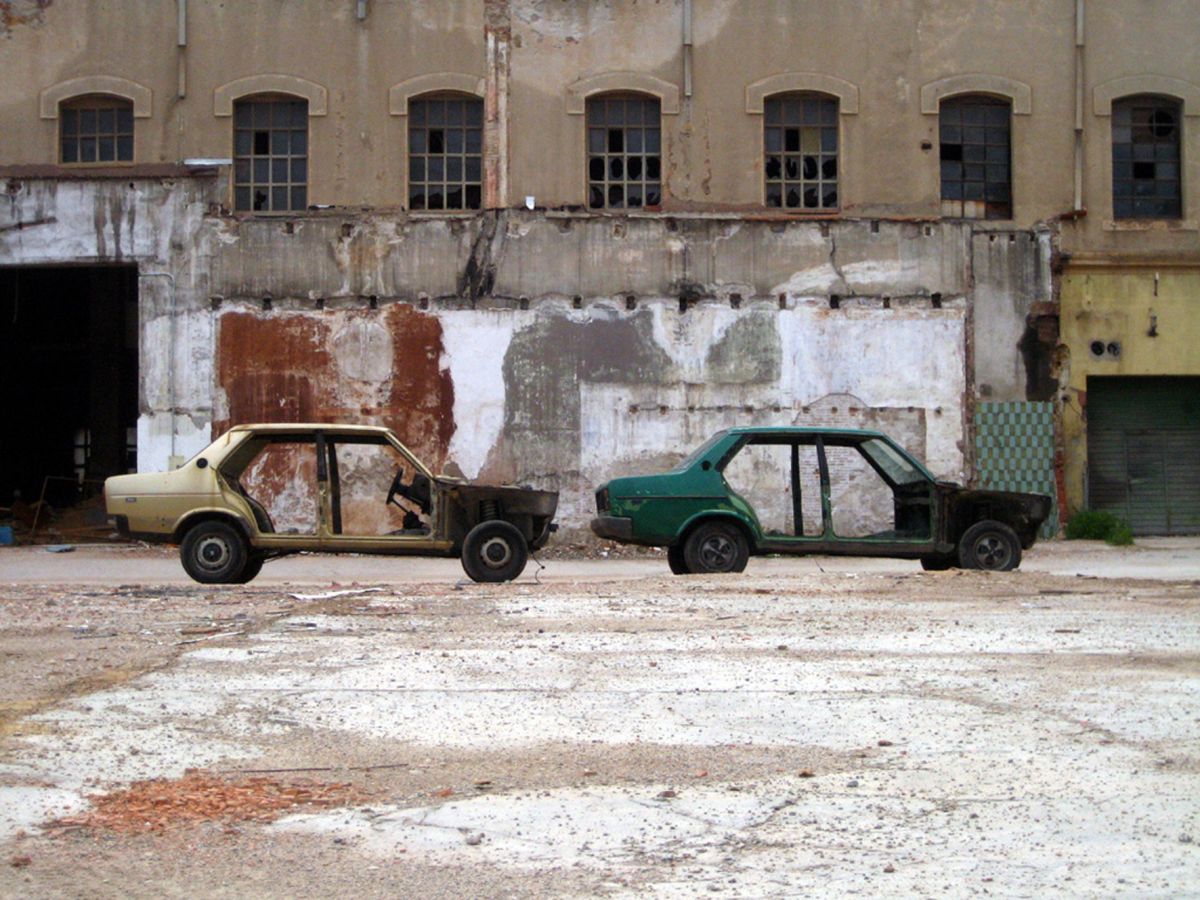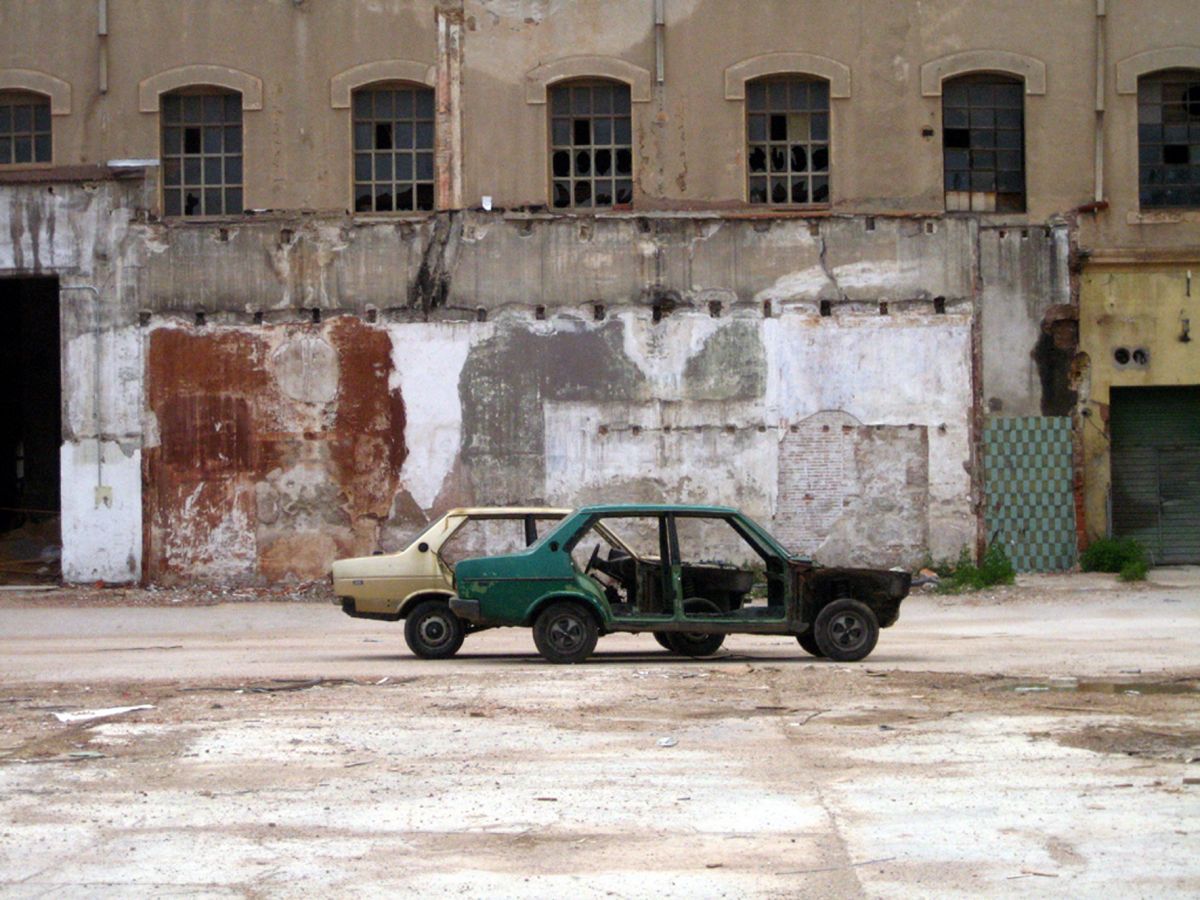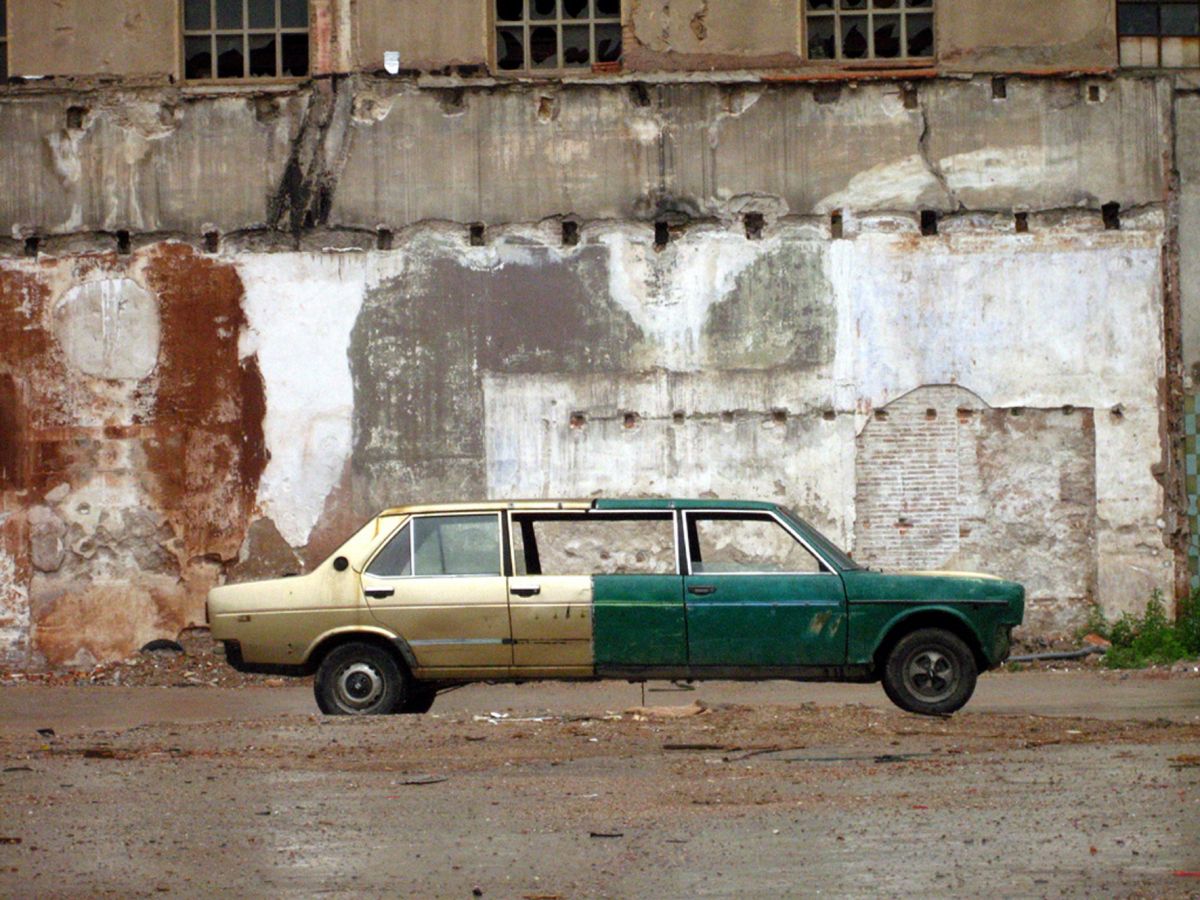Modern Essays 1
Across the Slope (2008)
Ahmet Öğüt
Salt Beyoğlu
June 16 – October 1, 2011
The first work to be exhibited in the series Modern Essays at SALT is Ahmet Öğüt’s Across the Slope. Originally shown in 2008 at Centre d’Art Santa Mònica in Barcelona, the installation consists of a modified Fiat 131 Mirafiori balanced precariously across a slope that takes over the floor of the gallery space.
The Fiat 131 Mirafiori was the dream car of the 1970s middle class in Turkey. In addition to domestic production, the 131 was manufactured in Turkey’s Tofaş factory as Murat 131, in Spain as Seat 131 and in Soviet Russia as Lada. It was also assembled in Southeast Asia, South America and North Africa. While Mirafiori’s design and engine were imported to these foreign markets, its assembly was local. The classic middle class car of its era, today Mirafiori remains a symbol of modernization, and an early example of a developing culture around custom-made cars. Öğüt’s version of the 131, like the American automobiles of the 1950s, is elongated beyond the needs of luxury.
Is this car on the slope just a modified Murat 131, or is it a middle class dream, suspended in mid-air?
An earlier work by artist Vahit Tuna titled The President’s Car (1998) tackled issues that arose from the transformation of the luxurious American cars imported to Turkey during the Democrat Party era. These cars that were used first by wealthy families, later became taxicabs and, finally, were modified in Dolapdere as eight-person shuttle buses. Ironically, these local articulations were visually reminiscent of limousines.
A comparison between American brands like Dodge or Chevrolet and Mirafiori embodies not only a Euro-American duality, but also the contrasting fantasies of the American and European middle classes. The helplessness of the working class eluded to in Öğüt’s Across the Slope can also be perceived in the composite photograph series Hip Activities-Escorts (2003-2005) by Aydan Murtezaoğlu. The car in Murtezaoğlu’s photographs is a 1968 Opel Rekord, manufactured the year of worldwide protests that represented the first great disappointment of the middle class after World War II.
In the 1960s, Turkish engineers produced the Devrim [Revolution], a prototype hand-made car. Öğüt first explored the Devrim in Today in History (2007), a series of stories and illustrations based on Turkish newspaper texts. Öğüt’s interest in the Devrim stemmed from the historic failure of its inaugural test-drive, the embarrassing result of an empty gas tank. Like the Devrim project, Across the Slope references the competitive spirit of national pride projects, as well as the invisible obstructions that middle class aspirations stumbled upon. It provides an alternative vantage point from which to deconstruct Turkish history.
Across the Slope can also be viewed as an extension of Öğüt’s Ground Control (2008), featured in the 5th Berlin Biennial, in which he covered a 400 sq. m. exhibition space with asphalt. Creating a chain of associations - including the demand for gas, asphalt’s origins in Southeastern Turkey, the country’s position as a cheap production base for the rest of the world, the dependency inherent to Turkey’s industrialization, the development of the autobahn, tire production and the assemblage industry - Öğüt’s work shapes a dialogue that touches on political, as well as economic issues.
Across the Slope will be accompanied by a video program exploring alternative readings of the work, to be presented in SALT Beyoğlu’s Walk-in Cinema.
Born in 1981 in Diyarbakır, Ahmet Öğüt lives and works in Amsterdam. Winner of the 2011 Volkskrant Beeldende Kunst Prijs and 2010 Kunstpreis Europas Zukunft, he has had solo exhibitions in numerous international institutions including Fondazione Giuliani per l’arte contemporanea, Rome; Kunsthalle Lissabon, Lisbon; Laumeier Sculpture Park, St. Louis; Artspace Visual Arts Centre, Sidney; Museum Villa Stuck, Münich; Kunsthalle Basel, Basel; Van Abbemuseum, Eindhoven; Centre d’Art Santa Mònica, Barcelona; Platform Garanti Contemporary Art Center, Istanbul; and Moderna Galerija, Ljubljana. He represented Turkey in the Pavillion of Turkey in the 53rd Venice Biennale with Banu Cennetoğlu and participated in Performa 09, New York; 5th Berlin Biennial; 9th International İstanbul Biennial; Guangzhou Triennial; 1st Contemporary Art Biennale of Thessaloniki; and Homeworks IV, Beirut.
Ahmet Öğüt explores daily struggles against restricted freedoms and the absurd encounters where the political meets the personal. Through various media such as drawings, sculptures, installations, video and artist books, Öğüt continues to produce works with a playful irony and subtle resistance.
The Fiat 131 Mirafiori was the dream car of the 1970s middle class in Turkey. In addition to domestic production, the 131 was manufactured in Turkey’s Tofaş factory as Murat 131, in Spain as Seat 131 and in Soviet Russia as Lada. It was also assembled in Southeast Asia, South America and North Africa. While Mirafiori’s design and engine were imported to these foreign markets, its assembly was local. The classic middle class car of its era, today Mirafiori remains a symbol of modernization, and an early example of a developing culture around custom-made cars. Öğüt’s version of the 131, like the American automobiles of the 1950s, is elongated beyond the needs of luxury.
Is this car on the slope just a modified Murat 131, or is it a middle class dream, suspended in mid-air?
An earlier work by artist Vahit Tuna titled The President’s Car (1998) tackled issues that arose from the transformation of the luxurious American cars imported to Turkey during the Democrat Party era. These cars that were used first by wealthy families, later became taxicabs and, finally, were modified in Dolapdere as eight-person shuttle buses. Ironically, these local articulations were visually reminiscent of limousines.
A comparison between American brands like Dodge or Chevrolet and Mirafiori embodies not only a Euro-American duality, but also the contrasting fantasies of the American and European middle classes. The helplessness of the working class eluded to in Öğüt’s Across the Slope can also be perceived in the composite photograph series Hip Activities-Escorts (2003-2005) by Aydan Murtezaoğlu. The car in Murtezaoğlu’s photographs is a 1968 Opel Rekord, manufactured the year of worldwide protests that represented the first great disappointment of the middle class after World War II.
In the 1960s, Turkish engineers produced the Devrim [Revolution], a prototype hand-made car. Öğüt first explored the Devrim in Today in History (2007), a series of stories and illustrations based on Turkish newspaper texts. Öğüt’s interest in the Devrim stemmed from the historic failure of its inaugural test-drive, the embarrassing result of an empty gas tank. Like the Devrim project, Across the Slope references the competitive spirit of national pride projects, as well as the invisible obstructions that middle class aspirations stumbled upon. It provides an alternative vantage point from which to deconstruct Turkish history.
Across the Slope can also be viewed as an extension of Öğüt’s Ground Control (2008), featured in the 5th Berlin Biennial, in which he covered a 400 sq. m. exhibition space with asphalt. Creating a chain of associations - including the demand for gas, asphalt’s origins in Southeastern Turkey, the country’s position as a cheap production base for the rest of the world, the dependency inherent to Turkey’s industrialization, the development of the autobahn, tire production and the assemblage industry - Öğüt’s work shapes a dialogue that touches on political, as well as economic issues.
Across the Slope will be accompanied by a video program exploring alternative readings of the work, to be presented in SALT Beyoğlu’s Walk-in Cinema.
Born in 1981 in Diyarbakır, Ahmet Öğüt lives and works in Amsterdam. Winner of the 2011 Volkskrant Beeldende Kunst Prijs and 2010 Kunstpreis Europas Zukunft, he has had solo exhibitions in numerous international institutions including Fondazione Giuliani per l’arte contemporanea, Rome; Kunsthalle Lissabon, Lisbon; Laumeier Sculpture Park, St. Louis; Artspace Visual Arts Centre, Sidney; Museum Villa Stuck, Münich; Kunsthalle Basel, Basel; Van Abbemuseum, Eindhoven; Centre d’Art Santa Mònica, Barcelona; Platform Garanti Contemporary Art Center, Istanbul; and Moderna Galerija, Ljubljana. He represented Turkey in the Pavillion of Turkey in the 53rd Venice Biennale with Banu Cennetoğlu and participated in Performa 09, New York; 5th Berlin Biennial; 9th International İstanbul Biennial; Guangzhou Triennial; 1st Contemporary Art Biennale of Thessaloniki; and Homeworks IV, Beirut.
Ahmet Öğüt explores daily struggles against restricted freedoms and the absurd encounters where the political meets the personal. Through various media such as drawings, sculptures, installations, video and artist books, Öğüt continues to produce works with a playful irony and subtle resistance.
In preparation for the opening on June 16, 2011, the modified Fiat 131 Mirafiori makes its entrance into SALT Beyoğlu...
Otomobil uçar gider
Performed by: Nesrin Sipahi
Lyrics: Vecdi Bingöl
Music: Münir Nurettin Selçuk





